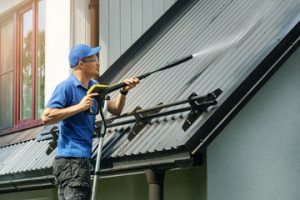Roof Cleaning begins where neglect quietly settles. It reveals how the sky’s gentle touch and nature’s persistence meet. Dust, moss, and mold shape their own silent architecture over time. Yet beneath them lies resilience waiting to be seen again.

The art of roof cleaning has moved beyond basic removal. It now integrates environmental science, surface chemistry, and precision engineering. The goal is not just to clean but to preserve structural harmony. Every method reflects balance between care and efficiency.
Modern systems rely on controlled pressure dynamics. Instead of relying purely on force, they use calibrated streams that adjust to material density. These patterns preserve tiles and shingles while removing deep-set grime. Power becomes thoughtful instead of destructive.
Recent innovations use bioreactive solutions that neutralize organic buildup. The process halts regrowth without releasing harmful residues. It redefines cleanliness as both visible and ecological. Sustainability merges with beauty on every rooftop.
Specialized sensors are changing how roofs are examined before cleaning. They map moisture levels, structural weakness, and temperature variance. This allows treatment tailored precisely to each section. Precision transforms what was once guesswork into science.
Roof cleaning has evolved into climate-conscious design maintenance. Surfaces now receive coatings that resist heat absorption after being cleaned. This reduces interior temperatures naturally. Energy efficiency begins with clarity above.
Engineers are studying how airflow during washing affects roof stability. Gentle oscillations reduce long-term stress on materials. It’s cleaning through rhythm rather than impact. Even water learns to move with intention.
Some researchers focus on acoustic-cleaning technologies. Vibrational frequencies loosen contaminants without physical abrasion. It’s silent cleaning through resonance. The harmony between sound and surface creates a future of whispering restoration.
Environmental microbiology contributes new understanding to this process. Specific microorganisms, once considered pests, are now harnessed to digest grime. They work as living cleansers that leave surfaces unharmed. Nature cleans itself through cooperation.
The design of rooftops is changing because of cleaning science. Architects now plan for maintenance efficiency alongside aesthetics. Slopes, drainage patterns, and material textures respond better to gentle washing. Function and beauty grow together.
Thermal imaging assists in detecting microbial growth beneath surface layers. Before visible discoloration, hidden colonies are mapped and treated. Prevention becomes as important as repair. Clean roofs begin in invisible spaces.
Self-regulating drones have entered this field as airborne custodians. Equipped with adaptive nozzles, they analyze reflectivity to adjust cleaning force. They hover precisely where buildup is thickest. The sky itself lends a hand in restoration.
The trend toward water reclamation defines modern roof cleaning ethics. Systems now recycle runoff through fine filtration and reuse it instantly. No drop is wasted, and no chemical leaves the cycle. Purity becomes circular, not linear.
Low-pressure steam applications have replaced many chemical treatments. Heat dissolves organic matter gently while sterilizing surfaces. It minimizes runoff impact and prevents recontamination. Warmth replaces harshness as the cleansing agent.
The future of roof cleaning may belong to programmable membranes. These adaptive coatings respond to sunlight and rainfall by self-activating gentle cleansing reactions. They prevent accumulation before it begins. The roof becomes its own caretaker.
Even the texture of water has been reimagined. Researchers manipulate droplet shape and cohesion through nanotechnology. This allows better adhesion to uneven surfaces and deeper cleaning with less volume. Every molecule works smarter.
Roof cleaning now intersects with psychology and well-being. Clean rooftops affect how occupants perceive safety and comfort. A well-maintained exterior influences peace of mind. Clarity above fosters calm within.
In residential environments, automation simplifies safety. Home systems schedule cleanings according to humidity and pollen data. Sensors notify owners before buildup becomes visible. Maintenance happens quietly, like an unseen guardian.
Restoration experts are studying how roof cleaning extends building life. The removal of biological films reduces corrosion and thermal stress. Cleanliness thus becomes preservation, not vanity. Every rinse saves years of endurance.
Even the pattern of spray has become a matter of design. Spiral jets disperse force evenly, preventing cracks in older materials. The flow mirrors natural rainfall for gentle rejuvenation. Technology imitates the sky’s patience.
Roof cleaning today acknowledges diverse materials beyond shingles. Green roofs, solar panels, and metallic layers each demand custom care. Adaptive tools identify composition through visual analytics. Each surface receives a voice and response.
Ecological roof cleaning embraces rainwater integration. Collected stormwater, purified through microfiltration, powers modern systems. Nature provides what it takes away. The loop of sustainability completes itself above our heads.
Architectural preservation groups now treat cleaning as cultural responsibility. Ancient temples and old dwellings are restored with microfoam applications. These foams dissolve dirt molecule by molecule without abrasion. History breathes again without losing its skin.
The relationship between roof color and cleaning frequency is being explored. Darker tones absorb pollutants faster, requiring new coatings that repel airborne particulates. This creates self-maintaining beauty over time. Cleanliness becomes color-conscious.
Automation in large complexes uses pattern learning. Systems remember previous sessions, optimizing water angles and detergent ratios. The roof becomes a living dataset of maintenance evolution. Memory replaces repetition.
The integration of ultraviolet sterilization represents a leap forward. Once washed, UV emitters neutralize remaining spores invisible to sight. It halts growth without altering the material. Sunlight becomes technology’s twin.
Climate adaptation reshapes cleaning frequency globally. Regions facing acid rain or drought need distinct approaches. Customization replaces one-size-fits-all maintenance. The act of cleaning aligns with geography’s rhythm.
Some laboratories develop micro-algae inhibitors derived from marine biology. These compounds prevent the spread of rooftop moss naturally. They mimic coral ecosystems’ defense mechanisms. Life protects life in cycles of invention.
The tactile artistry of manual roof cleaning remains irreplaceable. Experienced technicians sense material reactions by sound and touch. This craftsmanship complements automation, not competes with it. Human intuition still guides technology’s precision.
The sensory aspect of the process draws fascination. Watching grime melt under steady streams feels deeply satisfying. The transformation represents more than visual clarity—it mirrors renewal itself. People find mindfulness in the motion.
Innovators experiment with electrostatic-assisted cleaning. Charged droplets cling to contaminants through polarity rather than impact. This minimizes splashback and water loss. Electricity and water cooperate instead of conflict.
In sustainable construction, maintenance begins at the blueprint. Materials are now selected for washability and self-drainage. Builders anticipate future care as part of design. Cleanability becomes a built-in virtue.
Roof cleaning is entering robotics research as a form of intelligent mobility. Machines crawl along steep angles, guided by magnetic grips and vision sensors. They navigate edges safely where humans once risked balance. Technology ascends where fear once held ground.
Emerging systems use mist encapsulation to trap dust and spores midair. These microscopic nets prevent pollutants from drifting. It transforms cleaning into containment. Air stays clear as surfaces shine.
The industry’s innovation extends to waste transformation. Organic residue collected during cleaning can be repurposed into bio-compost. The process turns dirt into growth. Cleaning supports regeneration, not disposal.
Architectural aesthetics now consider how light interacts with a freshly cleaned roof. Reflection studies show cleaner surfaces enhance illumination inside. The interplay between cleanliness and light becomes part of spatial experience.
Weather-responsive coatings are being tested for adaptive reflection. These layers shift their composition slightly depending on climate, easing future cleaning cycles. Maintenance becomes a partnership with the atmosphere. The roof learns to live with change.
Eco-engineers develop enzyme-based cleaners that activate under sunlight. These biological agents degrade organic matter without artificial chemicals. The environment participates in the act of purification. Clean energy becomes literal.
Smart monitoring dashboards provide visual analytics of roof condition. Data visualization allows owners to track cleanliness levels like health metrics. The concept of a “roof lifespan score” emerges. Maintenance transforms into measurable wellness.
In educational design, green infrastructure studies highlight cleaning as part of sustainability education. Students learn that roofs are ecosystems, not static covers. Caring for them teaches balance between structure and soil. Learning begins at the top.
Drone-assisted infrared scanning detects buildup on reflective surfaces. Invisible films of oil or soot become visible through thermal contrast. Cleaning precision improves by knowing what cannot be seen. Discovery precedes renewal.
Water physics research dives into droplet rotation during spray cycles. Tiny vortices increase contact time on inclined surfaces. This means less water used and deeper cleansing achieved. Science choreographs water like dance.
Roof cleaning also affects biodiversity in subtle ways. Removing invasive moss restores native microbial balance. Clean surfaces allow designed green roofing to flourish properly. Care maintains ecological truth.
In the context of urban renewal, collective cleaning programs redefine skylines. Coordinated efforts make districts gleam together, creating psychological uplift. Brightness above translates into community pride. Clean roofs reflect collective progress.
Researchers explore anti-fungal nanoparticles infused in post-cleaning coatings. These particles activate under moisture, neutralizing spores instantly. Longevity becomes built into the surface. Protection continues long after the wash ends.
Robotic crawlers are evolving tactile awareness. They can sense tile temperature and vibration to assess fragility. Their gentle touch reflects a human instinct encoded in metal. The machine learns empathy through feedback.
Public health research links roof cleanliness to air quality. Algae and debris release spores and dust that enter ventilation systems. Regular maintenance prevents respiratory irritants. Clean surfaces silently guard wellbeing.
Advances in light scattering technology improve inspection accuracy. Laser grids project micro-maps of grime thickness. Algorithms calculate exact washing duration needed. Nothing is overdone, nothing ignored.
Roof cleaning influences energy performance more than expected. Reflective roofs maintain lower temperatures when properly maintained. Energy savings ripple into reduced emissions. The simple act of washing supports sustainability goals.
In flood-prone areas, roof cleaning ensures drainage systems function properly. Removing debris reduces overflow risk during storms. Cleanliness becomes protection against disaster. Maintenance turns into resilience.
Future studies may integrate atmospheric sensors with roof systems. These sensors detect pollutants and initiate micro-cleansing in response. The building becomes self-aware in its cleanliness. Intelligence and architecture merge.
The culture surrounding roof maintenance is shifting from chore to craft. People see roofs as living surfaces worthy of artful care. The ritual of cleaning embodies respect for shelter itself. Renewal becomes an act of gratitude.
As innovation deepens, the boundary between cleaning and conservation blurs. Roof cleaning no longer just maintains—it transforms, preserves, and connects. It speaks of balance between what protects us and how we protect it. Above every home lies a quiet revolution of renewal.








